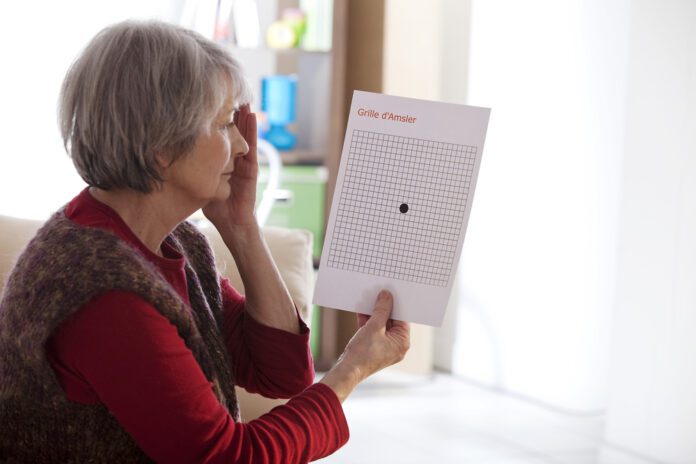Overview
Macular degeneration typically occurs in older people. It’s a medical condition that may result in blurred or no vision in the center of the visual field. The Macula: Center of the Retina is only a small part of the retina. It allows you to read small prints and shapes.
The macula is the central and most sensitive area of the so-called film. When it is working properly, the macula collects highly detailed images at the center of the field of vision and sends them up the optic nerve to the brain, which interprets them as sight. When the cells of the macula deteriorate, images are not received correctly. In the early stages, macular degeneration does not affect vision. Later, if the disease progresses, people experience wavy or blurred vision, and, if the condition continues to worsen, central vision may be completely lost. People with very advanced macular degeneration are considered legally blind. Even so, because the rest of the retina is still working, they retain their peripheral vision, which is not as clear as central vision. Its called Age-related macular degeneration (AMD).
Age-related macular degeneration happens when the macular which is the central area of the retina responsible for clear vision in the direct line of sight begins to deteriorate.
Macular Degeneration is the leading cause of vision loss, more than cataracts and glaucoma combined.
Cause
The exact cause of macular degeneration is not known. What is known, however, is that as the eye ages certain structural and functional changes occur in the retina that is important to the development of macular degeneration. Genetic and environmental factors may be involved as might lifestyle factors, including smoking and diet.
Symptoms
Signs and symptoms
Macular degeneration is a painless condition. Symptoms usually develop slowly and typically include:
● Difficulty reading or performing activities that require fine vision
● Need for brighter lighting when reading or doing close-up work
● Difficulty adapting to low levels of light
● The reduced intensity or brightness of colors
● The gradual increase in the cloudiness of central vision
● Distortion, i.e. straight lines appear wavy or crooked
● Distinguishing faces becomes difficult
● Dark patches or empty spaces appear in the center of the field of vision.
If you experience any of these symptoms – especially changes in the central vision, loss of fine detail, and colors losing their intensity – you should contact the optometrist or ophthalmologist promptly. Early diagnosis and treatment may reduce vision loss and, in some people, may improve vision.
Treatment
Treatment Of AMD In The Elderly
If age-related macular degeneration is indicated, treatments provided by expert ophthalmologists must be initiated as soon as possible to slow disease progression and reduce risks of vision loss. However, there are currently no documented cures for age-related macular degeneration. Early detection of age-related macular degeneration is critical so that sight can be saved.
Treatment depends on the type of AMD you have.
Dry AMD – there’s no treatment, but vision aids can help reduce the effect on life. Antioxidants and mineral supplements can help delay disease progression
Wet AMD – you may need regular eye injections and, very occasionally, a light treatment called “photodynamic therapy” to stop vision from getting worse.
Other
Types of Macular Degeneration
There are two types of macular degeneration: Dry AMD and Wet AMD
Dry AMD (also called non-exudative AMD) – Dry macular degeneration is a type of disease in which blood vessels in the eye do not leak. In most cases, it affects both eyes. Dry AMD gets progressively worse over the years. In dry AMD there are minimal symptoms in the early stages, with vision loss occurring in the mid to late stages. Sometimes only one eye is affected. In these cases, people tend to notice vision changes sooner as one eye begins to compensate for vision loss in the other.
Wet AMD (also called exudative AMD) – Wet AMD is a more advanced form of the disease and causes vision loss when abnormal blood vessels grow in the eye. Wet AMD occurs when the blood vessels leak below the center part of the retina, the macular. The leaking and bleeding cause permanent vision loss. In some cases, the individual had dry AMD that progressed to wet AMD.
The three stages of AMD
Age-related macular degeneration has three distinct stages. They are:
● Early AMD: Individuals do not experience vision loss in the early stages of the disease. However, the symptoms may be detected by a comprehensive eye exam. The ophthalmologist may detect yellow deposits beneath the retina. Early detection is important so that treatments that may slow the progression of the disease can begin.
● Intermediate AMD: In the mid-stages of AMD there may be some vision loss but not enough to alarm the individual. A comprehensive eye exam may detect changes in the retina.
● Late-stage AMD: In the late stages of the disease, people begin to experience central vision loss.
Source
https://www.allaboutvision.com/conditions/amd.htm https://www.macular.org/what-macular-degeneration https://lowvisionmd.org/whats-the-difference-between-wet-and-dry-age-related-macular-degeneration/ https://www.southerncross.co.nz/group/medical-library/macular-degeneration-causes-symptoms-treatment https://www.southerncross.co.nz/group/medical-library/macular-degeneration-causes-symptoms-treatment https://www.mdfoundation.com.au/content/treatments-macular-degeneration



